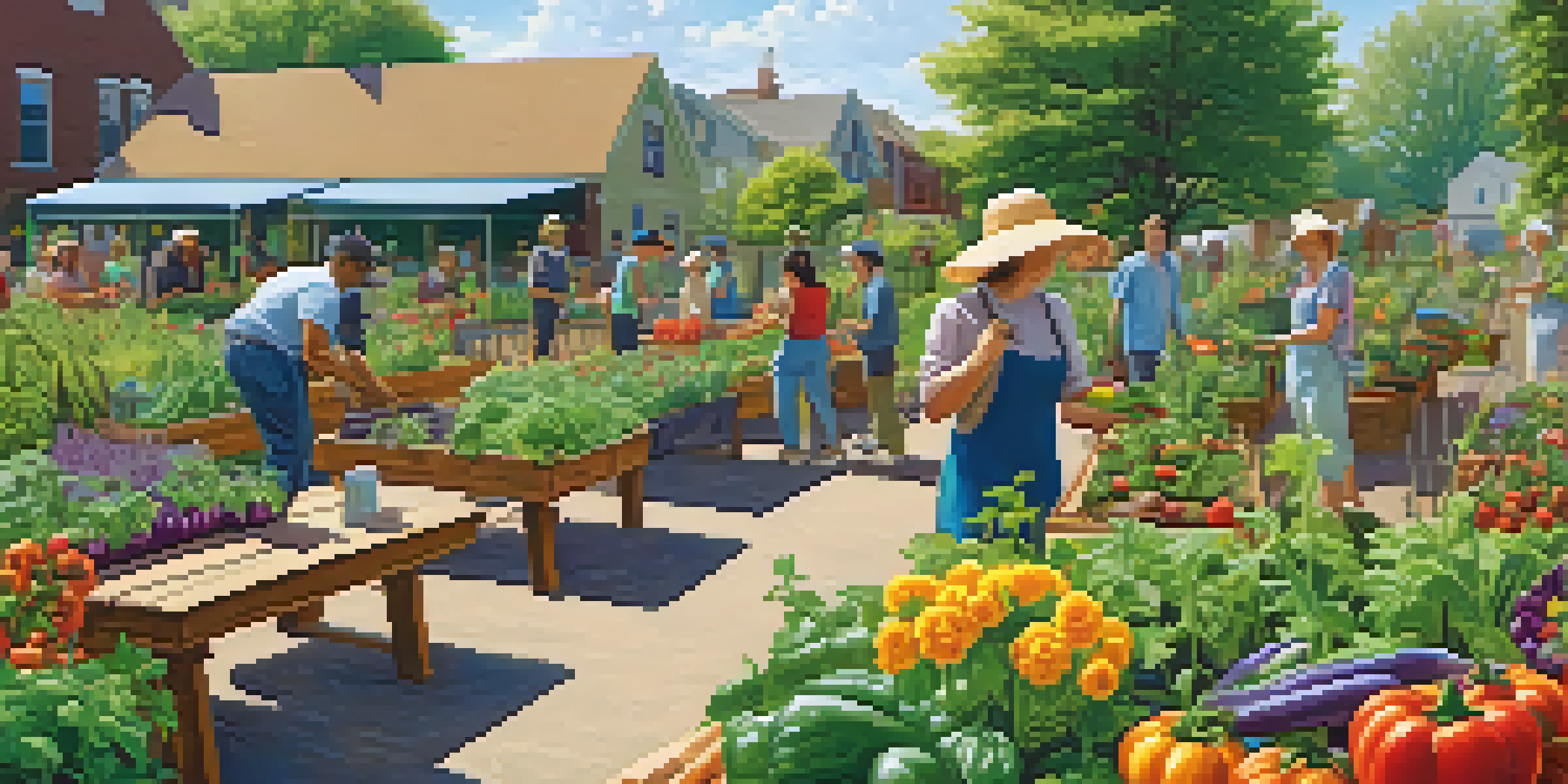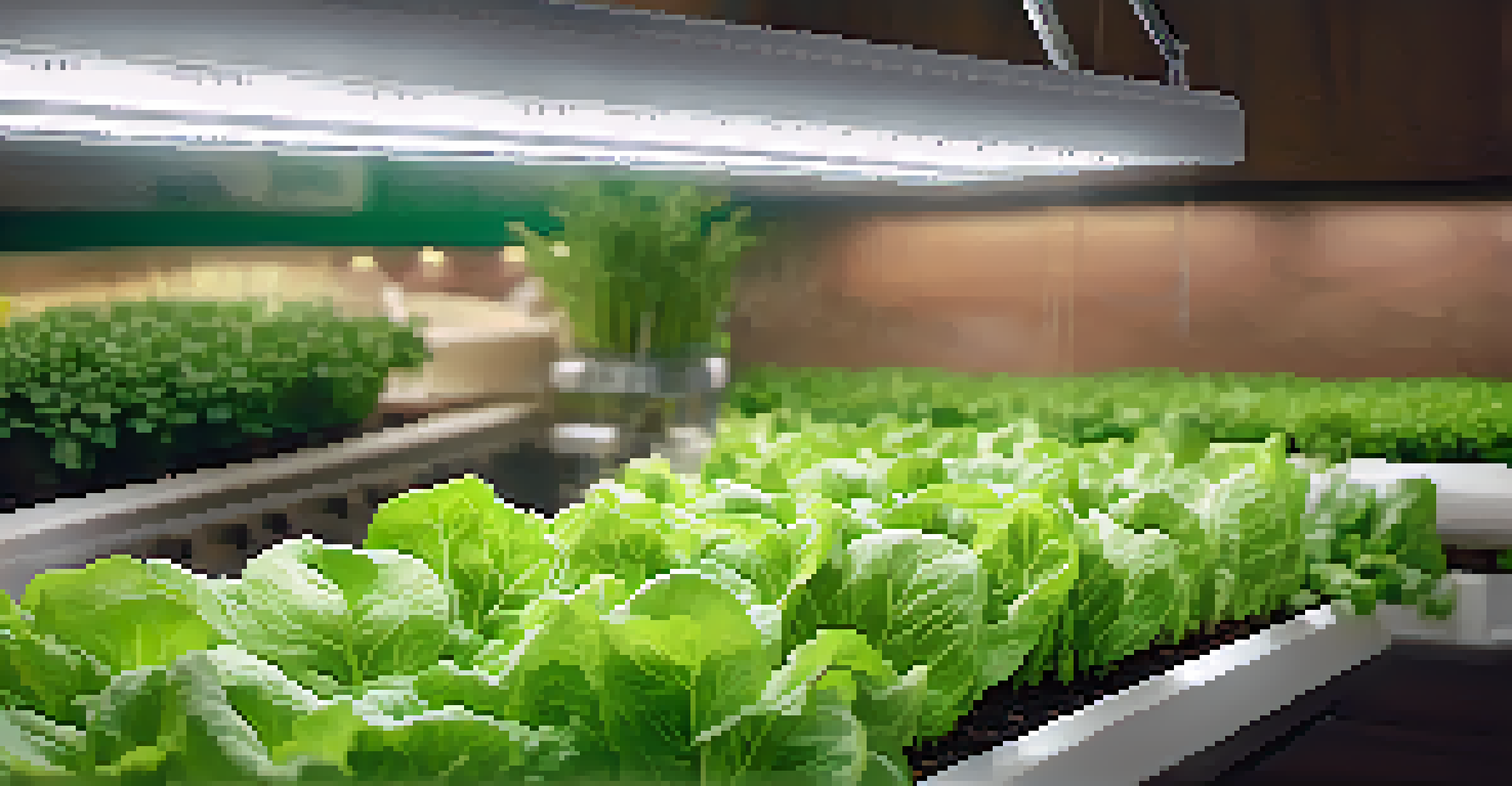Sustainable Urban Farming: Techniques for City Dwellers

Understanding Sustainable Urban Farming Basics
Sustainable urban farming refers to growing food within city limits while focusing on environmental health. This practice not only provides fresh produce but also supports local ecosystems. By utilizing available spaces like rooftops, balconies, and community gardens, city dwellers can contribute to a greener urban landscape.
The greatest threat to our planet is the belief that someone else will save it.
The goal of sustainable urban farming is to create a food system that reduces waste and energy consumption. For instance, using composting techniques helps recycle organic waste into nutrient-rich soil. This approach not only enhances plant growth but also minimizes landfill contributions.
Moreover, sustainable urban farming fosters community engagement. Neighbors can come together to share knowledge, resources, and even harvests, creating a sense of belonging. Such collaboration is vital for building resilient urban communities that prioritize sustainability.
Container Gardening: A Space-Saving Solution
For those with limited space, container gardening is a fantastic option. It allows individuals to grow vegetables and herbs in pots, making it perfect for balconies or small yards. Plus, the mobility of containers means you can move them to maximize sunlight exposure.

When selecting containers, consider materials that retain moisture well, such as ceramic or plastic. Additionally, ensure proper drainage to prevent waterlogging, which can harm plants. By using a mix of potting soil and compost, you can create a nutrient-rich environment for your plants.
Sustainable Urban Farming Benefits
Sustainable urban farming enhances food security, supports local ecosystems, and fosters community engagement.
Container gardening is not just practical; it can also be aesthetically pleasing. With vibrant flowers and lush greens, your urban space can become a beautiful sanctuary. Imagine sipping coffee on your balcony surrounded by your own thriving garden—it's a rewarding experience!
Vertical Gardening: Utilizing Vertical Space
Vertical gardening is an innovative technique that maximizes limited space by growing plants upwards. This method is perfect for city dwellers who want to create a garden without taking up too much ground space. Trellises, wall planters, and hanging baskets are all effective tools for this purpose.
In every walk with nature one receives far more than he seeks.
One of the significant benefits of vertical gardening is that it can improve air circulation and sunlight exposure for plants. Climbing plants like beans and peas thrive in these conditions, resulting in healthier crops. Additionally, vertical gardens can provide insulation for buildings, contributing to energy efficiency.
Creating a vertical garden also adds visual interest to your urban environment. A wall covered in greenery can be a stunning focal point, attracting pollinators like bees and butterflies. This not only beautifies your space but also supports local biodiversity.
Hydroponics: Soil-less Gardening in the City
Hydroponics is a cutting-edge method of growing plants without soil, using nutrient-rich water instead. This technique is especially beneficial for urban farming, where soil quality can be a concern. Hydroponics systems can be set up indoors or outdoors, making them versatile for city dwellers.
One of the advantages of hydroponics is its efficiency; it uses significantly less water than traditional gardening methods. The controlled environment also allows for year-round growing, meaning you can enjoy fresh produce regardless of the season. Popular crops include lettuce, herbs, and strawberries.
Container and Vertical Gardening
These gardening methods maximize limited space in urban areas, allowing city dwellers to grow their own food.
However, setting up a hydroponic system requires some initial investment and knowledge. Luckily, many resources are available online, and local workshops can help beginners get started. Once established, hydroponic gardens can be incredibly rewarding and productive.
Community Gardens: Growing Together
Community gardens are shared spaces where neighbors come together to grow food collaboratively. These gardens not only provide fresh produce but also foster a sense of community and shared responsibility. Participating in a community garden can be a great way to meet like-minded individuals and learn from each other.
Many community gardens also emphasize sustainable practices, such as composting and organic gardening. By working together, members can share tools, seeds, and knowledge, making gardening more accessible for everyone. This collective effort can lead to a bountiful harvest and a stronger community bond.
In addition to growing food, community gardens often serve as educational hubs. Workshops on gardening techniques, sustainability, and cooking can empower participants to make healthier choices. Thus, community gardens contribute not only to food security but also to community well-being.
Permaculture: Designing Sustainable Urban Ecosystems
Permaculture is a holistic approach to gardening that focuses on creating sustainable ecosystems. This design philosophy emphasizes working with nature rather than against it, making it highly relevant for urban farming. By understanding how different elements interact, you can create a self-sustaining garden.
In permaculture, the goal is to develop systems that are productive while minimizing waste. For example, using rainwater collection systems can provide irrigation without tapping into municipal water supplies. Additionally, companion planting encourages biodiversity, helping to naturally deter pests and improve crop yields.
Community Gardens Enhance Well-being
Community gardens not only provide fresh produce but also serve as educational hubs and strengthen community bonds.
Implementing permaculture principles in urban settings enhances resilience against climate change. By creating green spaces that mimic natural ecosystems, cities can better manage stormwater, reduce heat islands, and support local wildlife. This approach not only benefits individual gardeners but also the broader urban environment.
The Benefits of Urban Farming for City Dwellers
Urban farming offers numerous benefits that extend beyond just fresh produce. It promotes food security by providing access to healthy and affordable food options in urban areas. This is especially important in food deserts, where residents have limited access to fresh fruits and vegetables.
Additionally, urban farming can improve mental health and well-being. Gardening has been shown to reduce stress and promote mindfulness, creating a peaceful retreat amidst the hustle and bustle of city life. The act of nurturing plants can foster a sense of accomplishment and connection to nature.

Moreover, engaging in urban farming contributes to environmental sustainability. By reducing the carbon footprint associated with transporting food, urban farms help lower greenhouse gas emissions. This shift towards local food production is essential for creating a more sustainable future for our cities.
Getting Started with Your Urban Farm Journey
Starting your urban farming journey can be both exciting and overwhelming, but it doesn’t have to be. Begin by assessing your available space and resources, whether it's a small balcony or a community garden plot. Setting realistic goals will help you stay motivated and enjoy the process.
Next, choose the right plants for your environment. Consider factors like sunlight, space, and your culinary preferences. Starting with easy-to-grow plants like herbs or salad greens can build your confidence and help you learn as you go.
Lastly, connect with local gardening groups or online communities. Sharing experiences, tips, and even plants can enhance your urban farming journey. Remember, every little effort counts towards creating a greener, more sustainable city!